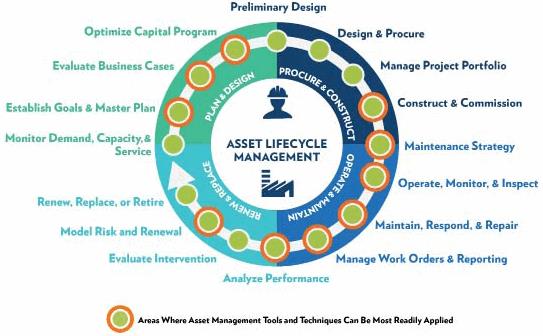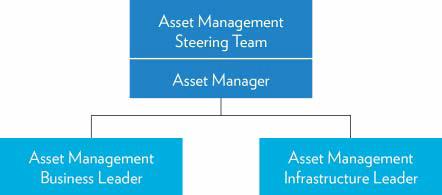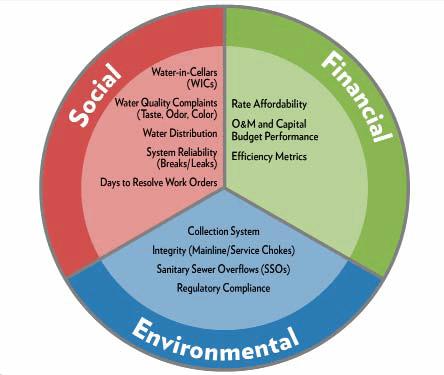Defining Your Asset Management Pathway
By David Sklar
How to create or enhance a utility asset management program using four simple tactics.
When water and wastewater utilities start to think about asset management, oftentimes the initial discussion centers around activities such as assessment, compliance, and reporting. The first words people hear are typically things like “lifecycle costing,” “asset hierarchies,” and “business risk exposure.” With all of the lexicon around asset management programs, it’s sometimes easy to lose sight of the fact that the real value is in the outcomes the program can deliver in terms of improved system reliability, quicker crew response, and a sharpened focus on renewal needs.
When thinking about asset management, it is important to remember that the data, systems, and analytics aren’t ends in themselves but must be integrated with more fundamental improvements to business processes. These must be embraced not just by asset management staff but by the entire organization. If an asset management program is to be truly transformative, it must go beyond analytics and deliver fundamental benefits that resonate with frontline employees involved in water and wastewater operations, maintenance, and customer service — the staff who deal most directly with the infrastructure and customers.

I often hear from utilities that have struggled with their implementation efforts: What can we do differently to start on a pathway that results in less theoretical and more actionable outcomes? Whether starting a new program or enhancing an existing one, establish a strong foundation and a practical approach. Although the U.S. municipal water sector is well past the “awareness” stage of asset management, the diverse drivers and lack of a specifically mandated framework means that utilities have a lot of flexibility in deciding how they want to approach and implement their programs. While common wisdom would still suggest drawing upon accepted industry standards such as ISO 55000 and the IIMM (International Infrastructure Management Manual), it is not necessary to check all the boxes to be successful. It’s important to remember that at its core asset management is still an approach and philosophy and offers a lot of flexibility to tailor a specific program to meet your needs.
To ensure short-term implementation successes, think of tactical outcomes: Can it make work easier and more efficient for field staff? Can it provide more accurate information to speed decision making? Can it help improve customer service and system reliability?
Staying true to some common principles, each utility is free to determine its own appropriate pathway by focusing on initiatives that are aligned with the organization’s overall strategic goals, achievable, and most likely to be impactful in the short term. There are four simple tactics that can help any water, wastewater, or stormwater utility enhance an existing program or start from a strong foundation.
Formalize The Team And Define Outcomes
Start by getting an energized team and ensuring they have ample time to dive in and get involved, are driven by a clear charter and mandate, and have active executive-level support. If needed, provide background training and education and promote collaboration and breaking down of silos — don’t just focus on planning and analysis but ensure equal roles for O&M, finance, and information technology. Set clear team expectations including milestones and target outcomes to track progress. While it’s important to have a strong leader(s), the asset manager also needs to stay grounded and realize that the asset lifecycle requires equal collaboration with O&M, which is responsible for most of the hands-on work throughout the life of the asset. In many cases, successful asset management programs appoint “asset owners” from O&M who work collaboratively with asset management team members to develop plans and make investment decisions. Avoid the “ivory tower” mentality and look to create an asset management structure that embraces the entire organization. For one city in the Southeast U.S., the asset management structure included an infrastructure leader residing in the O&M organization responsible for executing asset class strategies and appointing formal work planners and schedulers. The planner positions are experienced staff with CMMS “power user” expertise who also understand the details and realities of field work.

Define Priority Initiatives
Take an objective approach to defining priority initiatives and look past the typical asset management condition assessment and asset management plan development tasks. Don’t just focus on writing reports and manuals. Ask fundamental questions such as: Is this going to have a significant positive impact on our organization? Will customers benefit? Can we readily communicate the benefits to stakeholders and public officials? Be sure to pick both short-term and long-term activities and don’t focus only on maintenance, as asset management initiatives can span the entire lifecycle including planning, design, and construction. When establishing your priorities, quantify current cost and performance and develop specific metrics and milestones that are likely to demonstrate benefit within 12 months. This will help garner early support and pave the way for longer-term improvements. For one city in the Northeast, the asset management program was first implemented for linear infrastructure (sewers and water mains) in order to tackle critical issues with sewer overflows, basement backups, water main breaks, and water quality complaints. Once these service-level issues have been addressed and stabilized, the program will be rolled out across other asset classes over time.
Measure, Manage, And Communicate
Pick the right metrics and clearly understand how they will be used to communicate benefits and outcomes. Improving performance data, accuracy, and transparency are key tenets of asset management. While system-wide improvements can take years to manifest themselves, look for ways to demonstrate early positive trends using rolling averages as well as measuring localized and neighborhood improvements that demonstrate an approach focused on “service equity.” Most importantly, use metrics actively, openly, and transparently — if goals aren’t being achieved, be adaptable and change tactics as needed. Stay grounded with real and meaningful measures — think of areas that are visible to both staff and customers including water quality, system reliability, and response and restoration times for emergency events. For internal staff, consider metrics like work order backlog, preventive maintenance compliance, and asset failure rates.
Early on in the process, active communication is key. Use newsletters, posters, and brochures to inform staff and promote awareness. Creating simple, targeted, annual asset management updates can help ensure the support of customers, stakeholders, and elected officials. Many utilities across the U.S. are now publishing annual asset management reports with detailed metrics across social, financial, and environmental domains.

Understand Your Roadmap
Always consider the asset management program an evolving journey. Industry practice and technologies related to maintenance management systems, mobile technology, and condition assessment techniques continue to advance, and programs need to maintain step as well. Keep the program fresh with quarterly formal reviews and open discussions, involve new individuals, and don’t be afraid to change direction. Identify and incorporate new initiatives as the need arises, adapt to changing strategic plan priorities, and reprioritize as needed to keep a focus on delivering benefits. Focus your efforts by starting with smaller pilots and gain internal support for a more comprehensive rollout based on strong business cases and benefit justification. Create your own customized “living” road map that evolves and serves as your pathway to success.
About The Author
 David Sklar is a principal consultant with WSP | Parsons Brinckerhoff, a global engineering and professional services organization. Based in Washington, D.C., David leads the firm’s asset management and business strategy offerings within the water and utility sectors. He is a recognized industry leader with over 20 years of experience across energy, water, and public works. His key areas of expertise include asset management, environmental sustainability, capital planning, process improvement, and performance management. David holds a B.A. in economics from Boston University and an MBA in sustainability from the University of Colorado at Denver. www.wsp-pb.com/USA
David Sklar is a principal consultant with WSP | Parsons Brinckerhoff, a global engineering and professional services organization. Based in Washington, D.C., David leads the firm’s asset management and business strategy offerings within the water and utility sectors. He is a recognized industry leader with over 20 years of experience across energy, water, and public works. His key areas of expertise include asset management, environmental sustainability, capital planning, process improvement, and performance management. David holds a B.A. in economics from Boston University and an MBA in sustainability from the University of Colorado at Denver. www.wsp-pb.com/USA
